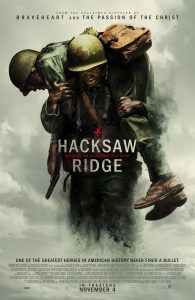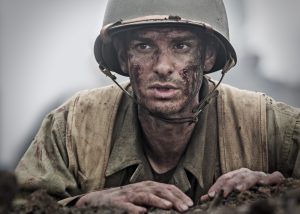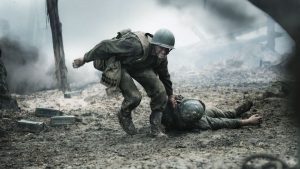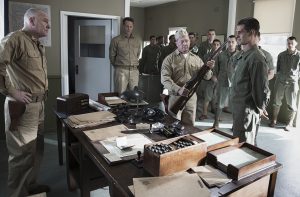
Mel Gibson faced criticism over the violence in “The Passion of the Christ.” Some found it to be gratuitous, reveling in Jesus Christ’s anguish. These critics felt he missed the point of it all, mistaking the bloody ordeal as the sacrifice. While I can see their point, I respectfully disagree. Mel “reveled” in the torture to showcase the horrors of the sacrifice, further driving home the point of the message. Was it excessive? Most definitely! It was excessive because Jesus Christ’s ordeal was excessive. It wasn’t pornographic as some deemed it, but authentic.
That same visceral authenticity is brought to “Hacksaw Ridge,” the account of a courageous soldier in World War II who never once fired a bullet. Said soldier is Desmond Doss (Andrew Garfield), a devout Christian who believes in saving lives as opposed to taking them. He enlists in the army to act as a combat medic, drawing the ire of his fellow recruits and superiors when he neglects to even carry a rifle, let alone shoot one. Alas, I’m getting ahead of myself.

Back to the visceral authenticity. Mel views war as it is: barbaric and grim. When the soldiers descend upon the battlefield, bullets fly freely and the flames of Hell are dispersed in the form of flamethrowers. The bullets pierce the skin, exposing ligaments and organs. Soldiers whizz by the screen ablaze, the Wilhelm Scream being put to work in overtime. Bodies are strewn about the place, decrepit and decaying. Rats gnaw on the flesh of the fallen, maggots slithering through the bones. Blood gushes from all corners, blinding some and no doubt making the faint of heart squeamish. I would not blame someone for mistaking these sequences as excerpts from a Lucio Fulci flick. They certainly play out like a horror film, replete with a jump scare of a believed-to-be-deceased soldier popping up for one last gasp of air.
Those who found “The Passion of the Christ” to be gratuitous will most certainly feel the same way about “Hacksaw Ridge.” Others will find the tone to be too forced and overindulgent. Again, while I can see their point, I respectfully disagree. The overindulgence is simple honesty, the forced nature befitting of war. War, much like Hell, is not pleasant and to show it as anything less than wicked would be a disservice. If anything, I praise Mel Gibson for not holding back, showing the aftermath of battle. It’s not pleasant and it’s not supposed to be. I also praise him for directing the battle scenes fervently, using modest quick cuts and furious pacing to mask some of the dodgier CGI. Fear not, as only some of the gunfire and blood squirts are CGI; the decaying bodies and battle scars are done with practical effects (or at least convincing CGI).

The viscera on display during the battles does combat the rather hokey tone of the human drama, so those who criticize the film for having awkward juxtaposition most definitely have a case on their hands. I was inclined to agree with them at first, but eventually found the awkward juxtaposition to work in the film’s favor. Desmond Doss is such an endearing optimist that the cheery tone on display during the grounded moments actually complements the horrors of war. His faith in humanity is challenged by the depravity of man. His dismissal of violence is a result of his fear of losing his humanity. He does not besmirch those who partake in violence as a means of defense, but it goes against his pride and religion to do so. By allowing him to exist in a Norman Rockwell painting is to give credence to his personality.
That’s not to say the film doesn’t suffer from the schmaltz. Robert Schenkkan & Andrew Knight’s screenplay is too sentimental for its own good, drowning in saccharine. The dialogue is too on-the-nose, with numerous exposition dumps posing as dramatic revelations. One story, belonging to Desmond’s father, Tom (Hugo Weaving), spells out his pain over losing a comrade too bluntly; it’s a long-winded diatribe centered around a blood-spattered uniform that feels scripted, not authentic. It’s only because of Weaving’s performance that any weight is brought to it. The same goes for the rest of the actors who fight an uphill battle in making some of the cheesier dialogue work. Andrew Garfield runs circles around Doss’ gawkiness, making his cringe-worthy attempts to flirt with Nurse Dorothy Schutte (Teresa Palmer) awkwardly charming. Him asking for his blood back because she’s made his heart beat too fast is so damn corny, yet both actors make it work. Again, it’s coyly juxtaposing Desmond’s innocence with the atrocities of reality. It’s formulaic for sure, but Gibson plays around with the formula to complement the uplifting message. Don’t let the depravity fool you; this is a feel-good crowd-pleaser at its core, just a savagely honest one.

Gibson isn’t off the hook, though. He stumbles at times, relying on amateurish techniques to convey drama. Mel utilizes conveniently timed flashbacks to Doss’ troubled childhood and brusque nightmare sequences to convey the protagonist’s fears, but they’re all fruitless. I already had an attachment to Doss and believed in his convictions. Therefore, I didn’t need these cheap parlor tricks to drive home the point. Strangely, I was forgiving of the just-as-cheap dialogue that spelled out the dismissals and admittances of the soldiers and superiors, though that’s because, as trite as their words may have seemed on paper, they felt organic and real in delivery. I believed Captain Glover (Sam Worthington) and Sgt. Howell (Vince Vaughn) when they barked dismissals at Doss, and believed them more so when they begged for his forgiveness.
The reason I’m more forgiving of the shortcomings of the second half is because of how smooth Gibson’s direction is of the war movie tropes. He’s aiming for cheerful excitement from the audience in the face of heroics and gets just that. The second half is structured as rudimentary, patriotic stimulation that is found in the most basic of war films. The bravado of victory in the face of danger overcomes the viewer, causing them to cheer as the heroes engage in battle. It’s hard not to cheer for Doss as he braves Hacksaw Ridge without a weapon, rescuing fallen comrades and even a few enemies. He does so by kicking and slapping away grenades and narrowly dodging bullets, almost a smack to the face of believability. It’s not because of the interview clips with the actual Desmond Doss that we believe his actions, but our acceptance of his conviction. I gave myself over to the theatrics and sentimentality by this point because it fell in line with the protagonist’s passion.

“Hacksaw Ridge” is a schmaltzy film, but a successful one at that. Only twenty-five percent of it is detrimental to the film, such as the hokey simplicity of Doss’ home life and Mel’s weird insistence on taking the piss out of Hollywood macho-ness in the form of a pretty-boy soldier given the moniker of Hollywood Zane (Luke Pegler). The remaining seventy-five percent is a rousing experience!
Final Rating: B+
